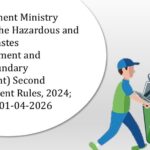The Urban Development Authority, Government of Tripura, through a notification dated 21st December, 2019, has notified the Tripura Construction and Demolition Waste Management Policy, 2019 (“The Policy”).
The Policy aims that by 2020 no Construction and Demolition Waste (“C&D Waste”) is dumped in open spaces and that at least 50% of the Construction and Demolition Waste generated is reused or recycled.
The Policy has defined three types of waste generators:
- Waste Generator (“WG”)- Defined by the Construction and Demolition Rules, 2016 (“C&D Rules”) as any person or association of persons or institution, residential and commercial establishments including Indian Railways, Airports, Ports and Harbours and Defence Establishments, who undertake construction or demolition of any civil structure which generate C&D Waste.
- Bulk Waste Generators (“BWGs”)- Waste generators who generate more than more than 20 metric tonnes or more in one day or 300 tonnes per project in a month will be labelled as BWGs.
- Service Provider- As identified under the C&D Rules, Service Providers are authorities who provide services like water, sewerage, electricity, telephone, roads, drainage and such other services, who often generate Construction and Demolition waste during such activities, including excavation, demolition and civil work.
Employers responsibility under the Policy:
- Every WG is responsible for collection, segregation, and storage of the Construction and Demolition Waste produced.
- All WGs must ensure that other waste is not mixed with the C&D Waste;
- BWGs are required to segregate their C&D Waste into 4 categories-
- i)Concrete;
- ii)Soil;
iii) Steel, wood and plastics; and
- iv)Bricks and mortar.
- BWGs have to maintain dedicated hook loader bins or skips that has to be kept within the construction site.
- BWGs will be responsible for transporting their waste to the processing plant and/or transit stations wither by themselves or through a contracted agency. The Urban Local Body (“ULB”) will have to make arrangements for collection and transportation of these C&D Waste from these processing plant/transit stations to processing and disposal facilities.
- Under the C&D Rules, BWGs are required to submit a waste management plan and get approval from the ULB before starting the construction, demolition or remodelling work. However the C&D Rules do not provide any format for such or give any details for the waste management plan. As a guidance to the ULBs, The Policy has provided a list of points which should be included in the waste management plan and advised the ULBs to appropriately accommodate them while framing the bye-laws/directions for management of the C&D Waste.
- For Small WGs of C&D Waste (like wastes resulting from petty construction, repair or maintenance work), the ULBs should consider-
- i)Deposit of C&D Waste by such WGs at collection centres; or
- ii)Removal of such C&D Waste by the ULBs themselves or through authorized private parties (on payment basis).
Grievance Redressal Mechanism
The Policy has laid down certain points for the ULB, for the creation of a robust grievance redressal mechanism (“GRM”) for the effective functioning of the C&D Waste management system:
- The GRM could be enabled through walk-in complaints, phone calls, SMS, online complaints, complaints through postal service and such other step as may be considered by the ULB, keeping in mind the population, per capita income, the available technology and the quantity of the C&D Waste generated.
- The ULB has to ensure that the grievances are addressed in a timely and efficient manner, keeping in mind the grievance, inconvenience caused to public and the remedial action proposed to be taken.
- The ULB has to make an area wise, periodic report of the number and type of complaints received, the action and time taken for resolving the grievance, feedback of the complainant and the pending complaints.
- The details of the complaints received and action taken also has to be made available on the ULB website and its office.
Source: Urban Development Authority, Government of Tripura




